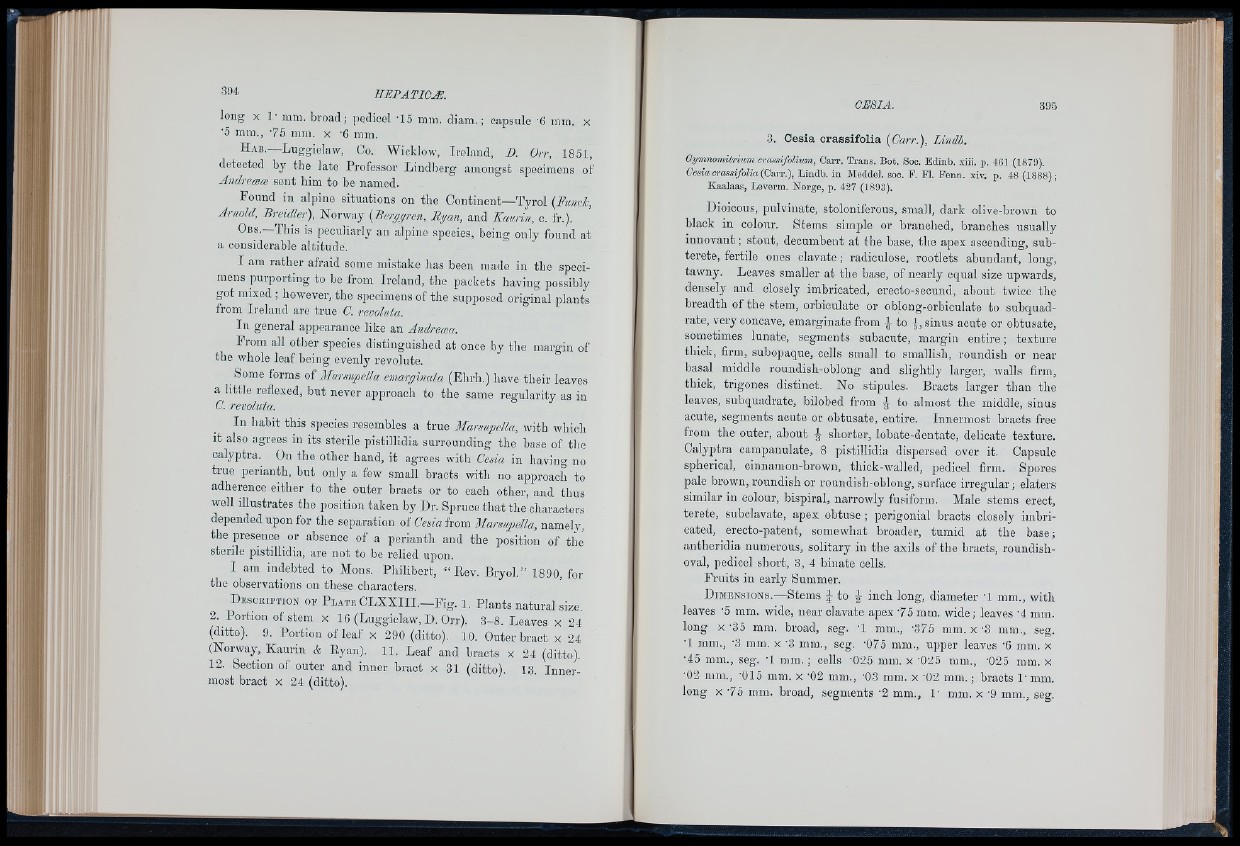
long X 1- mm. broad; jiedicel '15 mm. diam.; capsule '6 mm. x
•5 mm., -75 mm. x ’6 mm.
H ,vb.— Luggielaw, Co. Wicklow, Ireland, B. Orr, 1851,
detected by tlie late Professor Lindberg amongst specimens of
Audrema sent him to be named.
Found in alpine situations on the Continent—Tyrol [Fmick,
Arnold, Breidler), Norway (Berggren, By an, and Kaurin, c. fr.).
Obs.—This is peouiiarly an alpine species, being only found at
a considerable altitude.
I am rather afraid some mistake has been made in the specimens
purporting to be from Ireland, the packets having possibly
got mixed ; however, the specimens of the supposed original plants
from Ireland are true C. revoliita.
In general appearance like an Andrecea.
From all other species distinguished at once by the margin of
the whole leaf being evenly revolute.
Some forms of Marsupella emarginata (Ehrh.) have their leaves
a httle reflexed, but never approach to the same regularity as in
C. revoluia.
In liabit this species resembles a true Marsupella, with which
it also agrees in its sterile pistillidia surrounding the base of the
calyptra. On the other hand, it agrees with Cesia in having no
true perianth, but only a few small bracts with no approach to
adherence either to the outer bracts or to each other, and thus
well illustrates the position taken by Dr. Spruce that the oharacter.s
depended upon for tlie separation of Cesia from Alarsupella, namely,
the presence or absence of a perianth and the position of the’
sterile pistillidia, are not to be relied upon.
I am indebted to Mons. Pliilibert, “ Rev. Bryol.” 1890, for
the observations on these charaoters.
D e s c r i p t i o n o e P l a t e C L X X III.-F ig . 1 . Plants natural size.
2. Portion of stem x 16 (Luggielaw, D. Orr). S-8. Leaves x 24
(ditto). 9. Portion of leaf x 290 (ditto). 10. Outer braot x 24
(Norway, Kaurin & Eyan). 11. Leaf and bracts x 24 (ditto).
12. Section of outer and inner bract x 31 (ditto). 13. Innermost
braot X 24 (ditto).
3. Cesia crassifolia (Carr.), Lindb.
Gymnomitrium crassifoHum, Carr. Trans. Bot. Soc. Edinb. xiii. p. 461 (1879).
Cesia crassifolia (Carr.), Lindb. in MeddeJ. soo. F. Fl. Fenn. xiv. p. 48 (1888);
Kaalaas, Leverm. Norge, p. 427 (1893).
Dioicous, pulvinate, stoloniferous, small, dark olive-brown to
black in colour. Stems simple or branched, branohes usually
innovant; stout, decumbent at the base, the apex ascending, sub-
terete, fertile ones clavate; radiculose, rootlets abundant, long,
tawny. Leaves smaller at the base, of nearly equal size upwards,
densely and closely imbricated, erecto-secund, about twice the
breadth of the stem, orbiculate or oblong-orbioulate to suhquadrate,
very concave, emarginate from ^ to I, sinus acute or obtusate,
sometimes lunate, segments subaoute, margin entire; texture
thick, firm, suhopaque, cells small to smallish, roundish or near
basal middle roundish-oblong and slightly larger, walls firm,
thick, trigones distinct. No stipules. Bracts larger than the
leaves, snbquadrate, bilobed from ^ to almost the middle, sinus
acute, segments acute or obtusate, entire. Innermost bracts free
from the outer, about ^ shorter, lobate-dentate, delicate texture.
Calyptra campanulate, 8 pistillidia dispersed over it. Capsule
spherical, cinnamon-brown, thick-walled, pedicel firm. Spores
pale brown, roundish or roundish-oblong, surface irregular; elaters
similar in colour, hispiral, narrowly fusiform. Male stems erect,
terete, subclavate, apex obtuse; perigonial bracts closely imbricated,
erecto-patent, somewhat broader, tumid at the base;
antheridia numerous, solitary in the axils of the bracts, roundish-
oval, pedicel short, 3, 4 binate cells.
Fruits in early Summer.
D im e n s i o n s .—Steins J to inch long, diameter '1 mm., with
leaves '5 mm. wide, near clavate apex ‘75 mm. wide; leaves ’4 mm.
long X -35 mm. broad, seg. '1 mm., '375 mm. x -3 mm., seg.
•1 mm., -3 mm. x ’3 mm., seg. '075 mm., njiper leaves '6 mm. x
•45 mm., seg. •! mm.; cells -025 nun. x -025 nun., -025 mm. x
•02 nun., -015 mm. x -02 mm., -03 mm. x -02 mm.; bracts P mm.
long X -75 mm. broad, segments -2 mm., 1- mm. x -9 mm., seg.